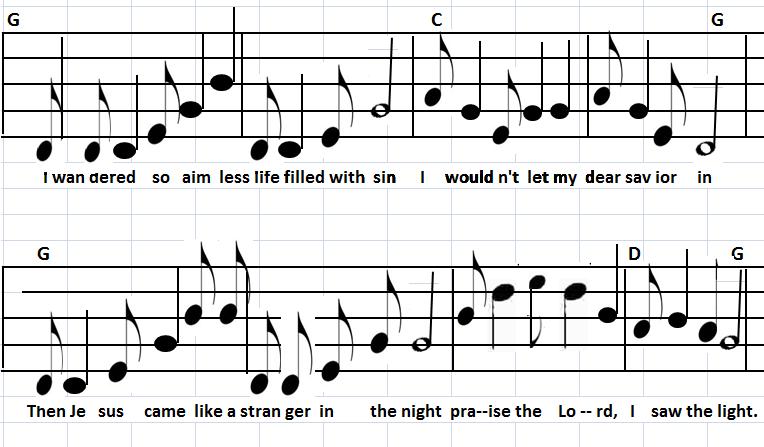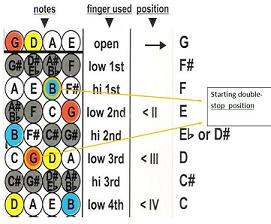The tune:
I Saw the Light was written by Hank Williams Sr.
The lick:
This is another sliding double stop--a G chord in this case,and instead of sliding up and right back
down to first position like in Dear Old Dixie, you get to hang out in third position a bit and noodle around the
melody. The lick we want doesn't occur until the 7th measure of the song,
so I'll write out the first 8 measures in music notation.
This might not be exactly the way it was first written, but I have heard a lot of people sing it
something close to this way, and you probably have, too.
 The first part of the 7th measure--where the singer hits the word "praise", and holds it--- is where the slide occurs.
the last half of the measure is where you can hang out in third position and noodle around with the melody, instead
of sliding immediately back down into first position.
That's just the way the intonation comes easier to me- I stay in third position on the 7th measure ("Prai--se the Lo-ord"), and then in the eighth
measure I'm back down in 1st position on the open A string ("I saw the light")
Getting out of higher positions seems to work better for me if I can find a spot where I have an open
string. If you're a better player than me, which is entirely likely, maybe you can be a little more agile in
this regard.
Playing it this way is the easiest way for me to keep it in
tune. You could slide that double stop back down to first position on "Lo--ord", but that just seems to introduce another way to
mess up the intonation without really adding anything to the sound.
So, what's happening this time? The slide move is exactly the same as in Dear Old Dixie, except the double stop (chord) is
different.
Instead of a C chord, this time you're moving a G chord up to third position.
So if you just move your fingerng for the Dear Old Dixie move up one string (to the right, as you look at
the Fiddlewidget diagram), that puts you in a G chord
A standard-tuned fiddle is in fifths, so you can move any note or double stop fingering position to the right
one string, and youre automatically going to be a fifth higher. You don't need to really think about it.
I'll try to tab this move, and show the Fiddlewidget screenshots that illustrate it a little better.
Here's the same Fiddlewidget diagram of the G major double stop you are sliding up, with the double stop notes circled in yellow
The first part of the 7th measure--where the singer hits the word "praise", and holds it--- is where the slide occurs.
the last half of the measure is where you can hang out in third position and noodle around with the melody, instead
of sliding immediately back down into first position.
That's just the way the intonation comes easier to me- I stay in third position on the 7th measure ("Prai--se the Lo-ord"), and then in the eighth
measure I'm back down in 1st position on the open A string ("I saw the light")
Getting out of higher positions seems to work better for me if I can find a spot where I have an open
string. If you're a better player than me, which is entirely likely, maybe you can be a little more agile in
this regard.
Playing it this way is the easiest way for me to keep it in
tune. You could slide that double stop back down to first position on "Lo--ord", but that just seems to introduce another way to
mess up the intonation without really adding anything to the sound.
So, what's happening this time? The slide move is exactly the same as in Dear Old Dixie, except the double stop (chord) is
different.
Instead of a C chord, this time you're moving a G chord up to third position.
So if you just move your fingerng for the Dear Old Dixie move up one string (to the right, as you look at
the Fiddlewidget diagram), that puts you in a G chord
A standard-tuned fiddle is in fifths, so you can move any note or double stop fingering position to the right
one string, and youre automatically going to be a fifth higher. You don't need to really think about it.
I'll try to tab this move, and show the Fiddlewidget screenshots that illustrate it a little better.
Here's the same Fiddlewidget diagram of the G major double stop you are sliding up, with the double stop notes circled in yellow
 |
1st position double stop (left) slides up to 3rd position (right), just like in Dear Old Dixie.
|
 |
If you write it out in tablature form, where the fingers used are shown as numbers on the strings, it would look something
like this;
The part highlighted in yellow is in 3rd position; everything else is in first.

This is probably more than enough discussion for what amounts to two measures of music.
There are a lot of ways to describe it, and they are all useful, but the Fiddlewidget diagram is the one that
most completely describes for me why I'm making this move and where I am in the scale/chord positions when I get there.
Bobby Hicks' Twinkle Little Star
Or return to the Higher Positions page.
Available from nationally known music suppliers, or call Bruce Haney at (423) 349-6715
or
email at bfhaney@chartertn.net.
 The first part of the 7th measure--where the singer hits the word "praise", and holds it--- is where the slide occurs.
the last half of the measure is where you can hang out in third position and noodle around with the melody, instead
of sliding immediately back down into first position.
That's just the way the intonation comes easier to me- I stay in third position on the 7th measure ("Prai--se the Lo-ord"), and then in the eighth
measure I'm back down in 1st position on the open A string ("I saw the light")
Getting out of higher positions seems to work better for me if I can find a spot where I have an open
string. If you're a better player than me, which is entirely likely, maybe you can be a little more agile in
this regard.
Playing it this way is the easiest way for me to keep it in
tune. You could slide that double stop back down to first position on "Lo--ord", but that just seems to introduce another way to
mess up the intonation without really adding anything to the sound.
So, what's happening this time? The slide move is exactly the same as in Dear Old Dixie, except the double stop (chord) is
different.
Instead of a C chord, this time you're moving a G chord up to third position.
So if you just move your fingerng for the Dear Old Dixie move up one string (to the right, as you look at
the Fiddlewidget diagram), that puts you in a G chord
A standard-tuned fiddle is in fifths, so you can move any note or double stop fingering position to the right
one string, and youre automatically going to be a fifth higher. You don't need to really think about it.
I'll try to tab this move, and show the Fiddlewidget screenshots that illustrate it a little better.
Here's the same Fiddlewidget diagram of the G major double stop you are sliding up, with the double stop notes circled in yellow
The first part of the 7th measure--where the singer hits the word "praise", and holds it--- is where the slide occurs.
the last half of the measure is where you can hang out in third position and noodle around with the melody, instead
of sliding immediately back down into first position.
That's just the way the intonation comes easier to me- I stay in third position on the 7th measure ("Prai--se the Lo-ord"), and then in the eighth
measure I'm back down in 1st position on the open A string ("I saw the light")
Getting out of higher positions seems to work better for me if I can find a spot where I have an open
string. If you're a better player than me, which is entirely likely, maybe you can be a little more agile in
this regard.
Playing it this way is the easiest way for me to keep it in
tune. You could slide that double stop back down to first position on "Lo--ord", but that just seems to introduce another way to
mess up the intonation without really adding anything to the sound.
So, what's happening this time? The slide move is exactly the same as in Dear Old Dixie, except the double stop (chord) is
different.
Instead of a C chord, this time you're moving a G chord up to third position.
So if you just move your fingerng for the Dear Old Dixie move up one string (to the right, as you look at
the Fiddlewidget diagram), that puts you in a G chord
A standard-tuned fiddle is in fifths, so you can move any note or double stop fingering position to the right
one string, and youre automatically going to be a fifth higher. You don't need to really think about it.
I'll try to tab this move, and show the Fiddlewidget screenshots that illustrate it a little better.
Here's the same Fiddlewidget diagram of the G major double stop you are sliding up, with the double stop notes circled in yellow


